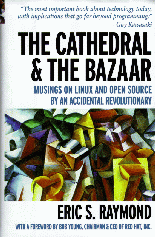

 |
 |

Beginning in 1992, Eric S. Raymond has jotted notes and comments that were (and still are) net-accessible. Since 1996, several of his essays (most notably ``The Cathedral & the Bazaar'') have become required reading. If anything, the obloquy heaped on Raymond by the PR folks in Redmond, WA (e.g., in the ``Halloween documents'') has made him more important.
O'Reilly has done us all a good favor by collecting a number of Raymond's pieces and making them readily accessible at a price everyone can afford.
The volume contains ``A Brief History of Hackerdom'', ``The Cathedral & the Bazaar'', ``Homesteading the Noosphere'', ``The Magic Cauldron'', ``The Revenge of the Hackers'' and ``Afterword'', plus two appendices.
These are the ``commonsense'' or the ``Federalist papers'' for the Open Source movement. They are the testimony of just why the BSDs and Linux, Perl and Python, Tcl and Java are successful: we have tens of thousands of programmers all over the world contributing to the excellence of programs and systems. We don't have an encapsulated proprietary system which no one can debug.
When I was writing A Quarter Century of UNIX (Addison-Wesley, 1994), I realized that essential to the ``UNIX philosophy'' was something alien to commercial programming: the changes to the kernel, the applications and the programs were all written by one or two or three hackers, not by teams of programmers. Eric Allman wrote Sendmail; Mike Lesk wrote the original uucp (even the mid-1980s version, HoneyDanBer, was by Peter Honeyman, Dan Nowitz and Brian Redman); Steve Johnson wrote yacc; Bill Joy wrote vi, etc. Brian Kernighan once told me AWK was the toughest project he ever worked on ``because there were three of us'' (Aho, Weinberger and Kernighan).
Of course, it's all the Internet's fault. Even with the semi-annual USENIX tape-swaps and uucp, stuff passed about more slowly. It's the Net that enabled a Finnish student to send his work to nearly every corner of the world and enabled thousands to contribute and feed stuff back to him.
In some ways, ``The Magic Cauldron'' is my favorite essay of Raymond's. Here, he shows that he understands the underlying economic reasons for the success of open software. This understanding is based on the anthropological study of gift exchanging and the concepts of what happens in a gift culture when ``survival goods are abundant'', and therefore, the exchange is no longer interesting.
This is tied together with the notions inherent in the fact that software has two distinct values: use value and sales value. As Raymond says, use value is value as a tool; sales value is value as a salable good. One of Raymond's most interesting discussions is founded in this.
Food, equipment and books all retain value independent of the producer. If a farmer sells his farm, the food produced retains its value, etc. When a computer manufacturer (hardware or software) goes out of business or a line is discontinued, the price users are willing to pay plummets. The price users will pay is limited by ``the expected future value of vendor service''.
Open-source software forces the vendor into a world of service-fee-domination and exposes ``what a relatively weak prop the sale value of the secret bits in closed-source software was all along''.
The true advantage for all of us lies in the notion of high-quality software being built upon by the community, rather than being locked up in a vault or discontinued.
Raymond believes that in 2000/2001, Linux will be ``in effective control of servers, data centers, ISPs and the Internet, while Microsoft maintains its grip on the desktop''. Most likely, that's correct. But with the advent of products like StarOffice and WordPerfect for Linux, there may well be inroads into the desktop market as well.
This is a fine, thought-provoking book that should be read by anyone interested in computing: open, academic or proprietary.
Peter H. Salus, the author of A Quarter Century of UNIX and Casting the Net, is Editorial Director of SSC. He can be reached at peter@ssc.com.